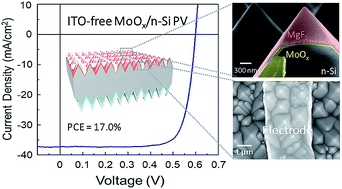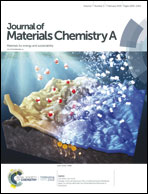ITO-free carrier-selective contact for crystalline silicon solar cells†
Abstract
In this study, an indium tin oxide (ITO)-free carrier-selective contact (CSC) for crystalline silicon (c-Si) solar cells with a micro-grid metal electrode is reported. The ITO layer is crucial for collecting the carriers separated at the junction between CSC and n-Si because of the relatively low conductivity of CSC. However, previous research investigated the formation of ITO films via sputter deposition, which can lead to performance degradation of solar cells due to the parasitic absorption of the ITO layer and plasma damage at the CSC/Si junction during sputtering. Moreover, the use of ITO is hindered because of the rare indium metal. Herein, we investigate the carrier transport mechanism at the MoOx/n-Si junction to understand the reason for the poor performance of ITO-free devices. A majority of the carriers are limited because of a highly resistive carrier path, with a sheet resistance of 16 kΩ sq−1 during carrier transport, leading to the severe degradation of fill factor (FF) and short-circuit current (Jsc). To minimize the power loss during carrier transport, a micro-grid metal electrode that can effectively collect carriers separated at the MoOx/n-Si junction is applied. With this micro-grid electrode, the electrical losses of ITO-free solar cells can be minimized despite the highly resistive path of the MoOx/n-Si junction. Hence, the best device exhibits a power conversion efficiency of up to 17.0% without the ITO layer.

- This article is part of the themed collection: Precious Elements


 Please wait while we load your content...
Please wait while we load your content...